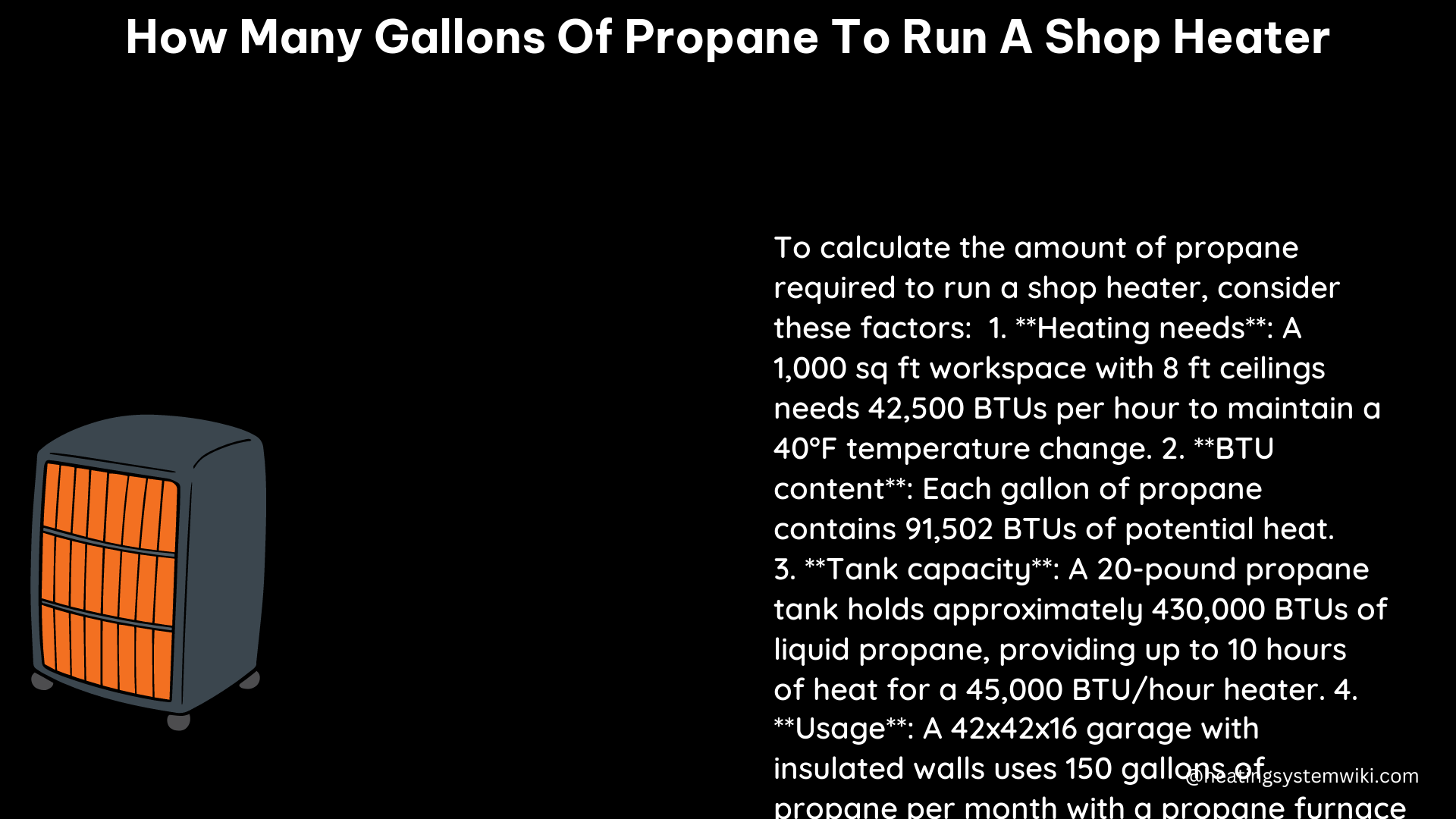When it comes to heating a workshop or garage, propane-powered heaters are a popular choice due to their efficiency, portability, and versatility. However, determining the exact amount of propane required to run a shop heater can be a complex task, as it depends on various factors. In this comprehensive guide, we’ll dive deep into the details to help you understand the intricacies of propane usage for your shop heater.
Factors Influencing Propane Consumption
The amount of propane needed to run a shop heater is influenced by several key factors:
-
Space Size: The size of the workspace, measured in square feet, is a crucial factor. Larger spaces require more BTUs (British Thermal Units) to maintain the desired temperature, which translates to higher propane consumption.
-
Desired Temperature: The target temperature you want to achieve in your shop or garage also plays a significant role. Higher temperature settings will result in increased propane usage.
-
Outdoor Temperature: The temperature difference between the inside of your shop and the outside environment is another important consideration. Colder outdoor temperatures will necessitate more propane to maintain the desired indoor temperature.
-
Heater Efficiency: The efficiency of the propane heater itself can impact the amount of fuel required. More efficient models will consume less propane to generate the same amount of heat.
-
Insulation: The level of insulation in your workshop or garage can greatly influence propane consumption. Well-insulated spaces retain heat better, reducing the overall propane needed to maintain the desired temperature.
Calculating Propane Consumption

To determine the precise amount of propane required to run a shop heater, you can use the following formula:
Propane Consumption (Gallons per Hour) = BTU Rating of Heater / BTU Content of Propane
The BTU content of propane is typically around 91,502 BTUs per gallon.
For example, let’s consider a 42,500 BTU propane heater in a 1,000 square-foot workspace with 8-foot ceilings, as mentioned in the initial answer. Using the formula, we can calculate the propane consumption:
Propane Consumption = 42,500 BTU / 91,502 BTU per Gallon
Propane Consumption = 0.46 Gallons per Hour
This means that a 20-pound propane tank, which holds approximately 4.7 gallons of propane, can run the heater for around 10 hours (4.7 gallons / 0.46 gallons per hour).
It’s important to note that this is a general calculation, and the actual propane consumption may vary depending on the specific conditions of your workshop or garage.
Factors Affecting Propane Consumption Rates
To further refine your understanding of propane usage, consider the following factors that can influence the consumption rate:
-
Heater Size and Setting: Larger heaters with higher BTU ratings will consume more propane than smaller, lower-capacity models. Additionally, running the heater at higher settings will increase the propane usage.
-
Insulation and Weatherproofing: Well-insulated and weatherproofed spaces retain heat more efficiently, reducing the overall propane required to maintain the desired temperature.
-
Outdoor Temperature Fluctuations: Significant changes in outdoor temperature can affect the propane consumption, as the heater will need to work harder to maintain the indoor temperature.
-
Heater Placement: The location of the heater within the workspace can impact its efficiency and, consequently, the propane usage. Proper placement, such as near the center of the space or in areas with good air circulation, can optimize the heater’s performance.
-
Propane Tank Size: The size of the propane tank can also influence the runtime and refueling frequency. Larger tanks, such as 100-pound cylinders, can provide longer continuous operation before needing a refill.
Monitoring and Adjusting Propane Consumption
To ensure efficient and cost-effective operation of your shop heater, it’s essential to monitor and adjust the propane consumption as needed. Here are some tips:
-
Track Propane Usage: Keep a record of your propane consumption, including the amount of propane used and the duration of use. This data can help you identify patterns and optimize your usage over time.
-
Adjust Heater Settings: Experiment with different temperature settings and heater outputs to find the most efficient balance between comfort and propane consumption.
-
Improve Insulation and Weatherproofing: Invest in upgrading the insulation and weatherproofing of your workshop or garage to reduce the overall heating load and propane requirements.
-
Consider Heater Efficiency: When selecting a new propane heater, prioritize models with high efficiency ratings to minimize propane usage.
-
Utilize Propane Usage Calculators: Online tools, such as the BTU calculator from Hot Propane, can help you estimate the propane consumption for your specific heater and workspace.
By understanding the factors that influence propane consumption and implementing these strategies, you can optimize the efficiency of your shop heater and ensure you have the right amount of propane on hand to keep your workspace comfortable and productive.
